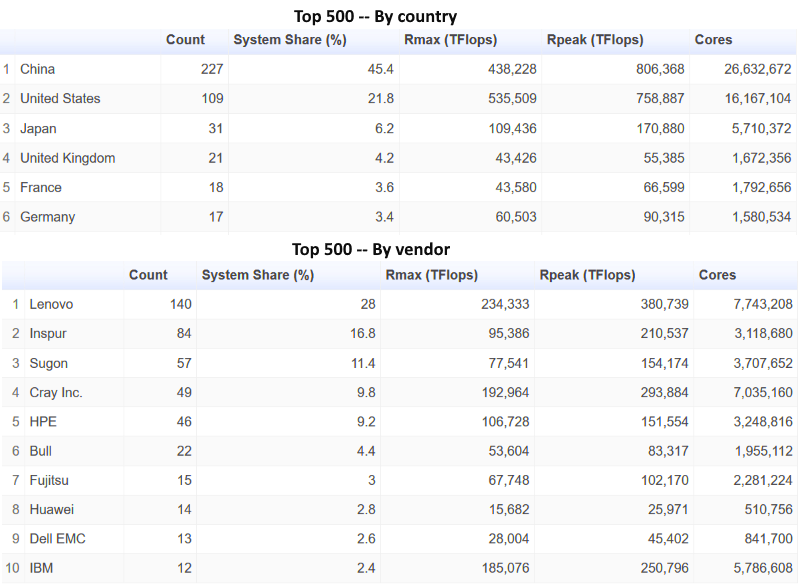Top 500 Shows China, U.S. Gains
China extended its lead in numbers of supercomputers, but the U.S. made gains in overall performance in the rankings released Monday. The latest Top 500 listcomes as China and the U.S. are running neck-in-neck in a race to deliver before 2022 exascale-class machine, 10 times more powerful than today’s largest systems.
China now has 227 Top 500 supercomputers, 45% of the total, while the U.S total fell to 109 (22%), an historic low. “That’s a big gap,” said Jack Dongarra, a professor of electrical engineering and computer science at the University of Tennessee and one of the organizers of the Top 500 list.
Vendors based in the People’s Republic have also taken leadership in supercomputing. China’s Lenovo, Inspur and Sugon are the thee top vendors in the current rankings.
Together with Huawei at No. 8, Chinese vendors installed 295 of the Top 500 systems. By comparison, four U.S. vendors in the top 10 — Cray, HPE, Dell EMC and IBM — installed 120 systems.
The good news for the U.S. is it still leads in overall performance at 38% compared to 31% for second-place China. Its position was boosted significantly when Summit and Sierra, the No. 1 and No. 2 systems, submitted updated results that boosted their performance levels to 143.5 and 94.6 petaflops, increases of more than 15% and 30%, respectively.
“The Summit system is quite impressive and represents 10% of the total Top 500 performance,” said Dongarra.
Sierra’s rise pushed China’s Sunway TaihuLight supercomputer into third place. The 93-petaflop system installed at the National Supercomputing Center in Wuxi was No. 1 on the Top 500 list for two years.

Both China and the U.S. have ramped up programs to deliver as many as three exascale systems each before 2022. The U.S. Department of Energy announced in April it is spending $1.8 billion on hardware alone for its program that includes separate spending on software.
“The U.S. is investing a tremendous amount for exascale. We could always use more, but it’s hard to say how much,” Dongarra said.
Three U.S. government labs will house its exasacle machines — Argonne, Livermore and Oak Ridge. China is expected to give a green light to three projects competing to deliver exascale systems as early as 2020.
One system is expected to use a China-designed CPU called the FT-2000 based on 64-bit ARM cores with vector extensions. China is designing its own chip, at least in part because the U.S. is putting restrictions on Intel supplying government-led projects its high-end Xeon chips that are widely used in supercomputers.
In recent years, China has been increasing the amount of silicon it designs for its high-end systems, including its own interconnect chips and accelerators.
For example, the Tianhe-2A, No. 4 on the latest list at 61.4 petaflops, uses a homegrown Matrix-2000+ accelerator, replacing an Intel Xeon Phi it used previously.
The Matrix-2000+ packs 128 cores in a 16nm device that delivers 2.048 teraflops/second at 2 GHz. A Matrix-3000 chip is expected to power one of China’s three exascale systems.
Nvidia continues to be one of the big winners in the Top 500 along with Intel whose Xeon chips are used in more than 90% of the systems. A total of 137 systems on the list used Nvidia GPUs as accelerators, up from 110 six months ago.
For example, both the No. 1 and No. 2 Summit and Sierra systems are IBM-built supercomputers, using its Power 9 CPUs and Nvidia V100 GPUs. Summit consists of 4,356 nodes, each with two 22-core Power 9s and six Tesla V100s linked on a Mellanox EDR InfiniBand network. Sierra is made up of 4,320 nodes with two Power 9s and four NVIDIA Tesla V100 GPUs.
Overall, the Top 500 now sports 429 systems delivering a petaflop/second or more, up from 272 systems six months ago. The BM-built Roadrunner system was the first to break the petaflop barrier in 2008.
A representative of the U.S. DoE will give an update on its exascale project this week at Supercomputing 2018 conference where the Top 500 list also will be revealed. European researchers will deliver an update on their exascale project at the event. In addition, a researcher from the University of Texas will unveil details of its plans for a next-generation system to replace its Blue Waters supercomputer with funding from the U.S. National Science Foundation.
在线留言询价

Pushing the boundaries of semiconductors
- 一周热料
- 紧缺物料秒杀
| 型号 | 品牌 | 询价 |
|---|---|---|
| CDZVT2R20B | ROHM Semiconductor | |
| BD71847AMWV-E2 | ROHM Semiconductor | |
| TL431ACLPR | Texas Instruments | |
| MC33074DR2G | onsemi | |
| RB751G-40T2R | ROHM Semiconductor |
| 型号 | 品牌 | 抢购 |
|---|---|---|
| BP3621 | ROHM Semiconductor | |
| TPS63050YFFR | Texas Instruments | |
| ESR03EZPJ151 | ROHM Semiconductor | |
| STM32F429IGT6 | STMicroelectronics | |
| IPZ40N04S5L4R8ATMA1 | Infineon Technologies | |
| BU33JA2MNVX-CTL | ROHM Semiconductor |
- 周排行榜
- 月排行榜
AMEYA360公众号二维码
识别二维码,即可关注

























